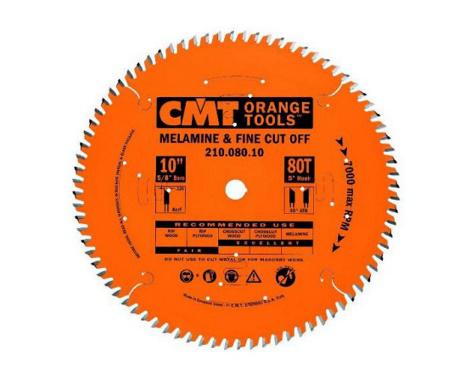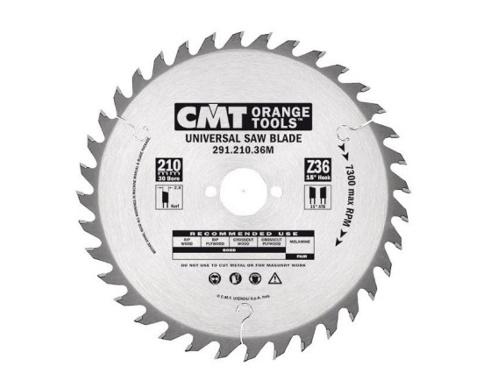Choosing a Circular Saw Blade
Circular saw blades come in many styles and tooth designs. How do I choose the one that is right for my application?
The material you are sawing and the direction of the cut has a lot to do with blade selection. Let’s first talk about wood with its naturally occurring grain. It’s generally easier to cut wood across the grain rather that with the grain. That’s because the cuts are usually shorter across the grain, the sap in the wood comes into play less, and any warpage in the wood usually has minimal effect on the cut. However, if you are cutting wood with the grain, it’s generally a longer cut where wood warpage and the straightness of the edge of the board can cause the wood to bind. Also, the sap in the wood is exposed to the sides of the blade longer when cutting with the grain thus slowing the blade down or binding it.This is not saying that a warped board and/or a crocked edge when cutting across the grain can’t create problems. Just try cutting such a board on a miter saw and have it bind and kick back against the miter saw fence. When this happens, it can be scary and even damage the fence. In summary, however, the above concepts are generally true.
Before leaving natural occurring wood with its various grains, let’s compare it to cutting meat. It’s much easier to cut meat across grain than with the grain. Meat tends to be pliable where wood isn’t which even makes the problem worse no matter which way you are cutting. However, both meat and wood are grainy and if you are cutting with the grain, you are trying to separate the material that binds the grains together. More of your knife or blade is exposed to the binding material which makes it much more difficult to cut.
How do I determine the best circular saw blade style for ripping or crosscutting? In general, the best blade for ripping has around 20 teeth with the hook angle on the teeth being around 20 degrees. If you are ripping and want a cut that can be used as a glue joint, manufacturers made blades with slightly more teeth and an 8 to 10 degree less hook angle. If you are gluing together a rip joint, the assumption is that you have relatively straight edge on the board(s) you are ripping. To summarize, the greater the hook angle, the more the teeth stick out from the body of the blade. The cut is wider with the blade body being narrower than the cut. This creates more space so the blade body doesn’t contact the sides of the cut resulting in less binding when sawing.

It then stands to reason, if you are crosscutting, you want a blade with more teeth and a lower hook angle than a ripping blade. Why is this? First, as mentioned in the introduction, it’s easier to cut across the grain than with the grain. Most crosscutting is done using a 12-inch or less wide board so there is less of a chance of binding versus a long board being ripped. However, made sure you have a straight edge against the fence of miter gauge and the board has little or no warpage or you can create a dangerous situation. Second, a smoother crosscut will be created with a blade with 60 to 80 teeth with a hook angle of 10 degrees or less. This type of blade also works well for cutting plywood, chipboard, Melamine, and laminates. For Melamine in particular, a blade with a tooth angle of 10 degrees or less will do fine on one-sided Melamine. However, is you are cutting two-sided Melamine and want to avoid chipping the bottom side of the cut, you want a blade with a zero or negative degree tooth angle.

How about buying a generalpurpose saw blade?These bladesusually have a relatively high hook angle like a ripping blade and around 35-40 teeth which can rip well but crosscutting is marginal.If you are doing rough carpentry or making a project that doesn’t require exact precision, this type of saw blade works well. As you can see, the type of saw blade you buy depends if you are doing rough carpentry or fine woodworking.
Finally, if you are cutting metal such as aluminum, copper, brass, pipe, steel bar or channel, you want a metal cutting saw blade with about 70 to 80 teeth and a zero to negative hook angle. This type of blade also works well for thin plastic, plexiglass, vinyl, and laminate flooring, or solid surface material.
There are several other factors to consider in buying a circular saw blade. One of the factors is the hardness of the carbide. A general rule is the lower number of teeth and the higher the hook angle, the lower the carbide hardness. Therefore, the higher number of teeth and the lower the hook angle, the higher the carbide hardness. Carbide hardness can be a blessing or a curse because the higher the carbide hardness, the longer the edge stays sharp but the easier the carbide will chip.
The other factor is the quality of the saw blade. This is a much more difficult issue to address. For some woodworkers or cabinet shops, it’s a matter of preference. Most manufacturers make different levels of quality. For framers for example, it’s more efficient to buy cheaper blades and just replace the old blade with a new blade. Others might buy an expensive blade and prefer to sharpen it when dull. In general, you should find a manufacturer who specializes in circular saw blades which will help insure quality laser cutting, grinding, tensioning, sharpening, and brazing and then choose the quality of blade for your specific application or preference.



